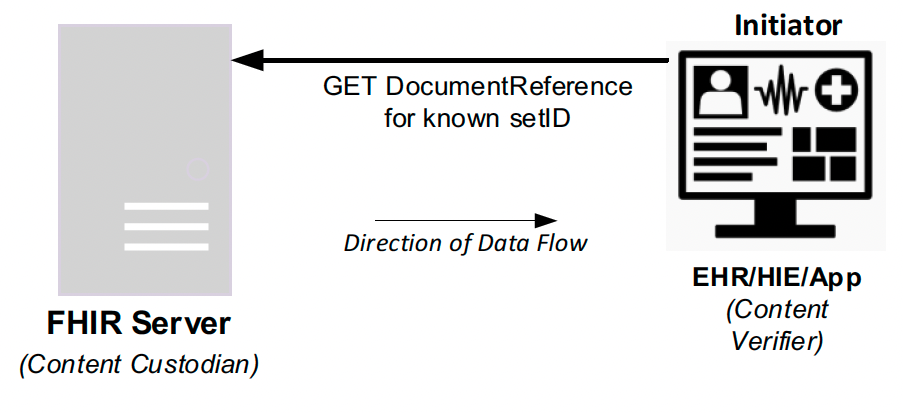This page is part of the PACIO Advance Directive Information Implementation Guide (v0.1.0: STU 1 Ballot 1) based on FHIR (HL7® FHIR® Standard) R4. The current version which supersedes this version is 1.0.0. For a full list of available versions, see the Directory of published versions
In ADI use cases, advance directive content created and updated will be represented using FHIR resources. The advance directives content is created and may be updated periodically by human actors. For advance directives information, there may be multiple human actors involved; however, there is only one author which is the patient. Other human actors may include the healthcare agent and alternate agents, witness, notary, provider, and data enterer.
System actors are responsible for ensuring the advance directive information is correctly represented using FHIR resources. The technical actor is responsible for carrying out activities to conduct transition exchanges.
Use cases in this IG will provide requirements for systems to use FHIR RESTful operations to both share (PUSH) and query & access (PULL) an individual’s advance directive content. In addition, it will cover technical requirements to update advance directive content. Finally, the use cases will provide guidance on verification. In this use case, verification addresses situations when you have advance directive information and you use FHIR RESTful operations to determine if what you have is current. The details for these use cases are provided below.

In Use Case 1, the person that wants to create their advance directive information in a digital form enters information in a content creator system. The content creator system ensures the information is stored and is available for the steps in the process that are described in the following use cases.
In Use Case 2, the Content Creator will share advance directive information with a Content Receiver using a FHIR API. The Content Receiver may be an end system or may be a Content Custodian.

In Use Case 2, the process is started when a person wants to share their advance directive information with a receiver. The person directs the Content Creator system to send the advance directive information to the Content Receiver through a FHIR based POST transaction. The Content Receiver will receive, store and process the advance directive information in their system.

In Use Case 3, there are 3 steps included.



In Use Case 3, the process is started when a Practitioner wants a person’s AD Info for care planning and decision-making. The Content Requester must contact a system that offers a FHIR API for receiving requests for advance directive information. The Practitioner must be authorized to access the person’s AD Info on the Custodian system. First the Content Requester will use a GET Patient request using patient matching information. The Content Custodian server returns all Patient resources to the Content Requester. If more then one Patient resource is returned, the Content Requester will confirm which is the correct patient. Then the Content Requester will use a GET DocumentReference using patient FHIR ID and any additional search parameters as supported and needed. The Content Custodian returns all matched DocumentReference resources to the Content Requester. If more then one DocumentReference is returned, the Content Requester will confirm which DocumentReference(s) are wanted. Finally the Content Requester will retrieve the wanted documents using a GET operation on the URL included in the DocumentReference and decode the document content if necessary.



In Use Case 4, the person that has previously created their advance directive information in a digital form wants to make updates to their information. The Custodian system ensures content is updated and correctly represented using FHIR resources.

In Use Case 4, the process is started by a person wanting to update previously created advance directive information. The precondition for the process includes the system is able to associate a new version of AD information as active and the ability to mark prior AD information version as inactive. First, the person creates an updated version of their AD information and stores it in a Content Custodian system responsible for information exchange using the same setID identifier as the replaced document and with status = “current”, relatesTo.code = “replaces”, and relatesTo.target –> prior version. Then, the prior version of AD information documentReference.status is changed to superseded. Finally, the person consents to share updated AD information. At the end of the process, the updated version is now the current active version and prior version is inactive and a relationship to the prior version of AD Info is maintained through DocumentReference.relatesTo.code (replaces).
Note: FHIR Resource versioning is only used for error corrections.

In Use Case 5, a Content Verifier has advance directive information which it previously received or retrieved.
superseded then the document has been replaced and the Content Verifier, the does a second query for a DocumentReference that has a relatesto.code of replaces and a reference to the superseded DocumentReference. The Content Verifier can then retrieve the document as described in step 3 of Use Case 3.

In Use Case 5, the process is started by a content verifier who would like to confirm they have the current version of advance directive information. The precondition for the process is the content verifier has a version of AD information from an earlier time. First, the content verifier performs a GET DocumentReference with known setID to content custodian. The content custodian returns the DocumentReference. If the DocumentReference returned has a status of superseded then the document has been replaced and the Content Verifier does a second query for a DocumentReference based on the relatesto.code referenced by the superseded DocumentReference. The content verifier will read the wanted documents using a GET operation on the uURL included in the “current” DocumentReference and decode the document content if necessary.

